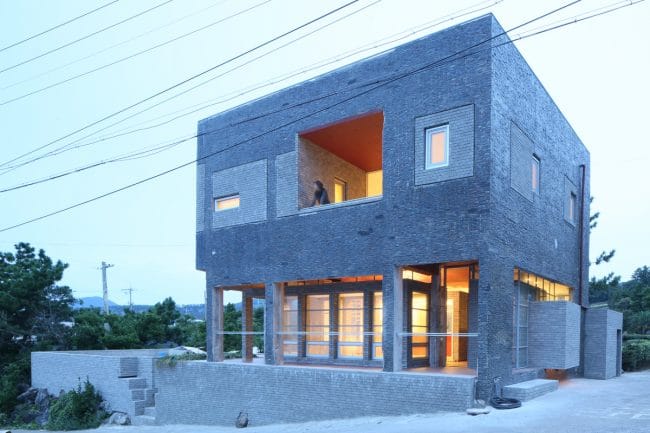처음 고려했던 재료들은 칼라강판, 투명폴리카보네이트등 재료의 내구성이 고려되었지만 바닷가의 염분에 견딜만한 재료를 찾지 못한 상태였는데 공사가 급하다보니 먼저 철거를 시작했고 그 과정에서 백색페인트로 칠해지기 이전의 재료가 붉은 색 타일임을 알게 되었다. 백색의 페인트가 칠해진 타일은 우리가 원하는 대로 깨끗이 떨어지지 않았다. 페인트만 벗겨진 타일, 타일모두가 벗겨진 부분, 타일을 부착했던 모르터를까지 떨어진 부분과 그것들이 혼합된 면들이 발견되었는데 그것이 현재의 마감으로 결정된 집이다. 언급하고 싶은 다른 점은 이 집의 주변상황이 인근의 동네와 동떨어져 있어 주변사람들의 접근이 적은 반면 올레길 탐방객이 많았지만 건물앞의 도로가 경사져 보행자의 직접적인 접근이 어렵다는 것인데 1층의 만들어질 커피숖에게는 불리한 지형이라는 것이 수리의 대상이 됬다는 것이다. 우리는 이 문제를 해결하기 위해 큰 도로에서 분리된 보행자 전용의 작은 길을 건물의 외곽에 내었고 그 길이 내부까지 연속될 수 있도록 내부공간을 세 개의 작은 볼륨으로 나누어 각각의 경계는 통로가 되도록 했다. 집속에 작은 동네 만든 것이다.
The materials initially considered were steel plates and transparent polycarbonate, but I could not yet find a material that can resist the salinity of the ocean water. However, we were in a hurry and began the process of demolition first. In this process, I found out that the material used was a dark coloured tile before it was covered with white paint. The tiles did not come off with ease as we had wished. I found tiles with chipped paint, completely peeled off paint, and parts where the mortar that kept the tile on the wall was chipped as well. Another thing I would like to mention is that the restaurant was at a distance from the nearby neighborhood and thus did not have many visitors. Moreover, it was difficult for people to approach the restaurant because the Jeju Olle Trail in front of the building was very steep. Therefore, I centred the reconstruction plan around the fact that a café would open up on the 1st floor. In order to solve this problem, I made a path for pedestrians that go from the main road leading to this building. Basically, I had made a small village within a house.
http://www.archdaily.com/778069/jeju-island-restaurant-refurbishment-moohoi-architecture-studio

